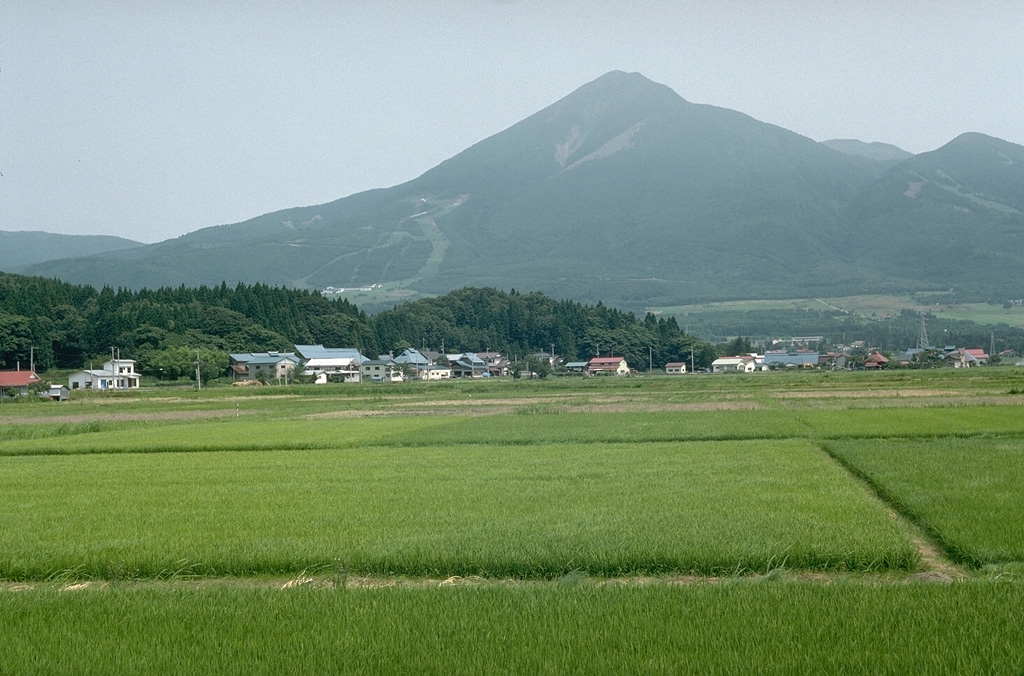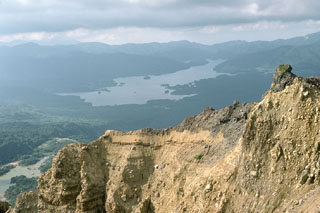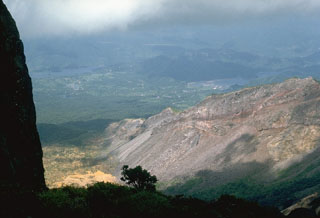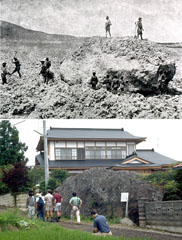

Mild, 45-second volcanic tremor in June 2012
Our previous report on Bandai (also called Bandai-san) discussed a significant increase in seismicity during 14-16 August 2000 (BGVN 25:08). However, no eruption resulted and no large change in GPS data was noted. The volcano is located in Fukushima Prefecture, Japan, about 220 km N of Tokyo (figure 2). This report notes that volcanic tremor was recorded in June 2012.
 |
Figure 2. A map of the major volcanoes of Japan. Bandai is just N of Tokyo. Courtesy of the U.S. Geological Survey. |
Recent monthly reports of volcanic activity from the Japan Meteorological Agency (JMA), translated into English, resumed in October 2010; the only recent report on Bandai was in June 2012. Thus, in this report, we lack JMA reports between January 2005 and May 2012 and only summarize activity during June 2012.
According to JMA, on 25 June 2012 volcanic tremor with a duration of 45 seconds was recorded, the first since 9 June 2009. No change in volcanic earthquakes, ground deformation, or fumarolic activity was observed. Volcanic earthquakes have remained at a low level at least through September 2012. A camera located at Kengamine (~7 km N of the summit) showed that gas emissions remained low, rising less than 100 m in height.
Information Contacts: Japan Meteorological Agency (JMA), Otemachi, 1-3-4, Chiyoda-ku Tokyo 100-8122, Japan (URL: http://www.jma.go.jp/).
The Global Volcanism Program has no Weekly Reports available for Bandaisan.
Reports are organized chronologically and indexed below by Month/Year (Publication Volume:Number), and include a one-line summary. Click on the index link or scroll down to read the reports.
Earthquake swarm
An earthquake swarm began 16 June, with 155 events recorded that day by the seismograph 2 km SSE of the summit (table 1). Epicenters were mainly concentrated 10 km SW. Seismicity decreased to
Table 1. Daily number of felt earthquakes at Wakamatsu Observatory, 10 km W of the epicentral area of the Bandai swarm, June 1987.
| Date | Felt Events |
| 16 Jun 1987 | 7 |
| 17 Jun 1987 | 2 |
| 18 Jun 1987 | 1 |
| 21 Jun 1987 | 2 |
| 23 Jun 1987 | 2 |
Information Contacts: Japan Meteorological Agency (JMA).
Increased seismicity
Seismicity increased toward the end of November. A total of 188 events were recorded by the seismometer 1.8 km NNW of the summit, up sharply from the background level of ~20/month (figure 1).
Information Contacts: JMA; AP; UPI.
Unprecedented increase in seismicity during 14-16 August
The last increase in seismicity at Bandai (located in the Fukushima prefecture about 20 km N of Tokyo) occurred in November 1988 (SEAN 13:11) when a total of 188 seismic events was recorded, up sharply from the background level of ~20 events/month. In contrast, at the same site up to 416 seismic events were recorded in one day when seismicity increased during 14-16 August 2000.
On the afternoon of 16 August the Japanese Meteorological Agency (JMA) issued a volcano advisory for Bandai. An abnormally high number of earthquakes, including felt earthquakes and volcanic tremor, was recorded at the A site seismometer 1.8 km SSE of the summit. The increase began on 14 August when 179 seismic events were recorded; this was the greatest seismicity to occur at the volcano since seismic monitoring began in 1965. On 14 August two of the four M 2 earthquakes that occurred were felt, and a volcanic tremor event lasted for 31 seconds. On 15 August the level of seismicity increased to 416 events, and two volcanic-tremor events lasted 40 and 55 seconds, respectively. At 2304 on 15 August a M 2.9 earthquake occurred, which was the largest event in the series. As of 1400 on 16 August there were 41 events. On 18 August a climbing ban was placed on the volcano. Due to the abnormally high level of seismicity, scientists monitored closely for signs of an impending eruption. Scientists observed no large change in GPS data or images from the monitoring camera. On 28 September officials lifted the climbing ban but warned climbers that an eruption could still occur.
Information Contacts: Volcano Research Center - Earthquake Research Institute (VRC-ERI), University of Tokyo, Yayoi 1-1-1, Bunkyo-ku, Tokyo, 113-0032 Japan (URL: http://www.eri.u-tokyo.ac.jp/VRC/index_E.html); Maki Kazuo, JMA-Sendai, 1-3-4 Ote-machi, Chiyoda-ku, Tokyo 100, Japan; The Japan Times.
Mild, 45-second volcanic tremor in June 2012
Our previous report on Bandai (also called Bandai-san) discussed a significant increase in seismicity during 14-16 August 2000 (BGVN 25:08). However, no eruption resulted and no large change in GPS data was noted. The volcano is located in Fukushima Prefecture, Japan, about 220 km N of Tokyo (figure 2). This report notes that volcanic tremor was recorded in June 2012.
 |
Figure 2. A map of the major volcanoes of Japan. Bandai is just N of Tokyo. Courtesy of the U.S. Geological Survey. |
Recent monthly reports of volcanic activity from the Japan Meteorological Agency (JMA), translated into English, resumed in October 2010; the only recent report on Bandai was in June 2012. Thus, in this report, we lack JMA reports between January 2005 and May 2012 and only summarize activity during June 2012.
According to JMA, on 25 June 2012 volcanic tremor with a duration of 45 seconds was recorded, the first since 9 June 2009. No change in volcanic earthquakes, ground deformation, or fumarolic activity was observed. Volcanic earthquakes have remained at a low level at least through September 2012. A camera located at Kengamine (~7 km N of the summit) showed that gas emissions remained low, rising less than 100 m in height.
Information Contacts: Japan Meteorological Agency (JMA), Otemachi, 1-3-4, Chiyoda-ku Tokyo 100-8122, Japan (URL: http://www.jma.go.jp/).
|
|
||||||||||||||||||||||||||
There is data available for 11 confirmed eruptive periods.
1888 Jul 15 - 1888 Jul 15 Confirmed Eruption (Explosive / Effusive) VEI: 4
| Episode 1 | Eruption (Explosive / Effusive) | Kobandai, RE1 tephra | |||||||||||||||||||||||||||||||||||||||||||||||||||||||||||||||||||||||||
|---|---|---|---|---|---|---|---|---|---|---|---|---|---|---|---|---|---|---|---|---|---|---|---|---|---|---|---|---|---|---|---|---|---|---|---|---|---|---|---|---|---|---|---|---|---|---|---|---|---|---|---|---|---|---|---|---|---|---|---|---|---|---|---|---|---|---|---|---|---|---|---|---|---|---|
| 1888 Jul 15 - 1888 Jul 15 | Evidence from Observations: Reported | |||||||||||||||||||||||||||||||||||||||||||||||||||||||||||||||||||||||||
|
List of 13 Events for Episode 1 at Kobandai, RE1 tephra
|
||||||||||||||||||||||||||||||||||||||||||||||||||||||||||||||||||||||||||
1808 (?) Confirmed Eruption (Explosive / Effusive) VEI: 2
| Episode 1 | Eruption (Explosive / Effusive) | Numanotaira | |||||||||||||||||||||||
|---|---|---|---|---|---|---|---|---|---|---|---|---|---|---|---|---|---|---|---|---|---|---|---|---|
| 1808 (?) - Unknown | Evidence from Observations: Reported | |||||||||||||||||||||||
|
List of 3 Events for Episode 1 at Numanotaira
|
||||||||||||||||||||||||
1787 (in or before) Confirmed Eruption (Explosive / Effusive) VEI: 2 (?)
| Episode 1 | Eruption (Explosive / Effusive) | |||||||||||||||||||
|---|---|---|---|---|---|---|---|---|---|---|---|---|---|---|---|---|---|---|---|
| 1787 (in or before) - Unknown | Evidence from Observations: Reported | ||||||||||||||||||
|
List of 2 Events for Episode 1
|
|||||||||||||||||||
[ 1767 ± 16 years ] Uncertain Eruption
| Episode 1 | Eruption (Explosive / Effusive) | Mt. Hanzawa (Bandai foothills) | ||||||||||||||||||
|---|---|---|---|---|---|---|---|---|---|---|---|---|---|---|---|---|---|---|---|
| 1767 ± 16 years - Unknown | Evidence from Unknown | ||||||||||||||||||
|
List of 2 Events for Episode 1 at Mt. Hanzawa (Bandai foothills)
|
|||||||||||||||||||
[ 1719 (in or before) ] Uncertain Eruption
| Episode 1 | Eruption (Explosive / Effusive) | ||||||||||||||
|---|---|---|---|---|---|---|---|---|---|---|---|---|---|---|
| 1719 (in or before) - Unknown | Evidence from Unknown | |||||||||||||
|
List of 1 Events for Episode 1
|
||||||||||||||
[ 1611 ] Uncertain Eruption
| Episode 1 | Eruption (Explosive / Effusive) | ||||||||||||||||||||||||
|---|---|---|---|---|---|---|---|---|---|---|---|---|---|---|---|---|---|---|---|---|---|---|---|---|
| 1611 - Unknown | Evidence from Unknown | |||||||||||||||||||||||
|
List of 3 Events for Episode 1
|
||||||||||||||||||||||||
0806 Confirmed Eruption (Explosive / Effusive) VEI: 3
| Episode 1 | Eruption (Explosive / Effusive) | O-Bandai, RE2 tephra | ||||||||||||||||||||||||||||
|---|---|---|---|---|---|---|---|---|---|---|---|---|---|---|---|---|---|---|---|---|---|---|---|---|---|---|---|---|---|
| 0806 - Unknown | Evidence from Observations: Reported | ||||||||||||||||||||||||||||
|
List of 4 Events for Episode 1 at O-Bandai, RE2 tephra
|
|||||||||||||||||||||||||||||
0550 BCE (?) Confirmed Eruption (Explosive / Effusive)
| Episode 1 | Eruption (Explosive / Effusive) | Numanotaira, RE3 tephra | ||||||||||||||||||||||||||||
|---|---|---|---|---|---|---|---|---|---|---|---|---|---|---|---|---|---|---|---|---|---|---|---|---|---|---|---|---|---|
| 0550 BCE (?) - Unknown | Evidence from Correlation: Tephrochronology | ||||||||||||||||||||||||||||
|
List of 4 Events for Episode 1 at Numanotaira, RE3 tephra
|
|||||||||||||||||||||||||||||
1800 BCE ± 1250 years Confirmed Eruption (Explosive / Effusive)
| Episode 1 | Eruption (Explosive / Effusive) | Numanotaira, RE4 tephra | ||||||||||||||||||
|---|---|---|---|---|---|---|---|---|---|---|---|---|---|---|---|---|---|---|---|
| 1800 BCE ± 1250 years - Unknown | Evidence from Correlation: Tephrochronology | ||||||||||||||||||
|
List of 2 Events for Episode 1 at Numanotaira, RE4 tephra
|
|||||||||||||||||||
3850 BCE (?) Confirmed Eruption (Explosive / Effusive)
| Episode 1 | Eruption (Explosive / Effusive) | HA-1.5 tephra | ||||||||||||||||||
|---|---|---|---|---|---|---|---|---|---|---|---|---|---|---|---|---|---|---|---|
| 3850 BCE (?) - Unknown | Evidence from Correlation: Tephrochronology | ||||||||||||||||||
|
List of 2 Events for Episode 1 at HA-1.5 tephra
|
|||||||||||||||||||
4650 BCE (?) Confirmed Eruption (Explosive / Effusive)
| Episode 1 | Eruption (Explosive / Effusive) | HA-1.6 tephra | ||||||||||||||||||
|---|---|---|---|---|---|---|---|---|---|---|---|---|---|---|---|---|---|---|---|
| 4650 BCE (?) - Unknown | Evidence from Correlation: Tephrochronology | ||||||||||||||||||
|
List of 2 Events for Episode 1 at HA-1.6 tephra
|
|||||||||||||||||||
5050 BCE (?) Confirmed Eruption (Explosive / Effusive)
| Episode 1 | Eruption (Explosive / Effusive) | HA-1.7 tephra | ||||||||||||||||||
|---|---|---|---|---|---|---|---|---|---|---|---|---|---|---|---|---|---|---|---|
| 5050 BCE (?) - Unknown | Evidence from Correlation: Tephrochronology | ||||||||||||||||||
|
List of 2 Events for Episode 1 at HA-1.7 tephra
|
|||||||||||||||||||
6350 BCE (?) Confirmed Eruption (Explosive / Effusive)
| Episode 1 | Eruption (Explosive / Effusive) | HA-1.8 tephra | ||||||||||||||||||
|---|---|---|---|---|---|---|---|---|---|---|---|---|---|---|---|---|---|---|---|
| 6350 BCE (?) - Unknown | Evidence from Correlation: Tephrochronology | ||||||||||||||||||
|
List of 2 Events for Episode 1 at HA-1.8 tephra
|
|||||||||||||||||||
7450 BCE (?) Confirmed Eruption (Explosive / Effusive)
| Episode 1 | Eruption (Explosive / Effusive) | HA-2.01 tephra | ||||||||||||||||||
|---|---|---|---|---|---|---|---|---|---|---|---|---|---|---|---|---|---|---|---|
| 7450 BCE (?) - Unknown | Evidence from Correlation: Tephrochronology | ||||||||||||||||||
|
List of 2 Events for Episode 1 at HA-2.01 tephra
|
|||||||||||||||||||
This compilation of synonyms and subsidiary features may not be comprehensive. Features are organized into four major categories: Cones, Craters, Domes, and Thermal Features. Synonyms of features appear indented below the primary name. In some cases additional feature type, elevation, or location details are provided.
Synonyms |
||||
| Bandai-san | Aizu-Fuji | Aizu-yama | Bandai | ||||
Cones |
||||
| Feature Name | Feature Type | Elevation | Latitude | Longitude |
| Akahani-yama | Stratovolcano | 1427 m | ||
| Kobandaisan | Stratovolcano | 1600 m | ||
| Kushiga-mine
Kusigamine |
Stratovolcano | 1636 m | ||
| Maruyama | Cone | 1359 m | ||
| Obandai | Stratovolcano | 1819 m | ||
Craters |
||||
| Feature Name | Feature Type | Elevation | Latitude | Longitude |
| Numanotaira | Crater | 1400 m | ||
 Lake Hibara in the distance was created in 1888 when the partial collapse of Ko-Bandai volcano produced a large debris avalanche that traveled 11 km, nearly to the far end of the lake. The area in front of the lake and the islands in the lake are part of the debris avalanche deposit. The steep wall in the foreground is part of the back headwall of the avalanche scarp.
Lake Hibara in the distance was created in 1888 when the partial collapse of Ko-Bandai volcano produced a large debris avalanche that traveled 11 km, nearly to the far end of the lake. The area in front of the lake and the islands in the lake are part of the debris avalanche deposit. The steep wall in the foreground is part of the back headwall of the avalanche scarp. Collapse of the summit of Kobandaisan peak during a phreatic eruption at Bandaisan volcano in 1888 created the 1.5 x 2 km scarp seen here. The lake in the foreground was formed on the irregular surface of a 1.5 km3 debris avalanche deposit. The avalanche buried several villages and blocked river drainages, forming several new lakes. Ashfall from the eruption reached the Pacific coast of Honshu.
Collapse of the summit of Kobandaisan peak during a phreatic eruption at Bandaisan volcano in 1888 created the 1.5 x 2 km scarp seen here. The lake in the foreground was formed on the irregular surface of a 1.5 km3 debris avalanche deposit. The avalanche buried several villages and blocked river drainages, forming several new lakes. Ashfall from the eruption reached the Pacific coast of Honshu. The steep topography at the right is the eastern rim of a scarp created by the 1888 collapse of Koandaisan, one of a group of cones forming Bandaisan. The two lakes in the distance, Onogawa (left) and Akimoto (right), formed after the resulting debris avalanche blocked river drainages. The caldera walls expose stratigraphy of pyroclastic deposits overlain by lava flows.
The steep topography at the right is the eastern rim of a scarp created by the 1888 collapse of Koandaisan, one of a group of cones forming Bandaisan. The two lakes in the distance, Onogawa (left) and Akimoto (right), formed after the resulting debris avalanche blocked river drainages. The caldera walls expose stratigraphy of pyroclastic deposits overlain by lava flows. Akahaniyama to the right is one of several cones that form Bandaisan, seen here above rice fields N of Lake Inawashiro. The forested ridge in the left foreground is part of an earlier Pleistocene debris avalanche deposit.
Akahaniyama to the right is one of several cones that form Bandaisan, seen here above rice fields N of Lake Inawashiro. The forested ridge in the left foreground is part of an earlier Pleistocene debris avalanche deposit. This massive boulder (top photo) was carried down the Biwasawa valley on the east side of Bandai volcano in a lahar during an eruption in 1888. The deposit covers the broad floor of the Nagase valley. In addition to this lahar, the 1888 eruption included a pyroclastic flow on the east side and a catastrophic debris avalanche that swept over villages to the north of the volcano. The bottom photo is taken from the same location a century later.
This massive boulder (top photo) was carried down the Biwasawa valley on the east side of Bandai volcano in a lahar during an eruption in 1888. The deposit covers the broad floor of the Nagase valley. In addition to this lahar, the 1888 eruption included a pyroclastic flow on the east side and a catastrophic debris avalanche that swept over villages to the north of the volcano. The bottom photo is taken from the same location a century later. The following 3 samples associated with this volcano can be found in the Smithsonian's NMNH Department of Mineral Sciences collections, and may be availble for research (contact the Rock and Ore Collections Manager). Catalog number links will open a window with more information.
| Catalog Number | Sample Description | Lava Source | Collection Date |
|---|---|---|---|
| NMNH 101500 | Unidentified | -- | -- |
| NMNH 113860 | Hypersthene Andesite | -- | -- |
| NMNH 113885 | Hypersthene Andesite | -- | -- |
| Copernicus Browser | The Copernicus Browser replaced the Sentinel Hub Playground browser in 2023, to provide access to Earth observation archives from the Copernicus Data Space Ecosystem, the main distribution platform for data from the EU Copernicus missions. |
| MIROVA | Middle InfraRed Observation of Volcanic Activity (MIROVA) is a near real time volcanic hot-spot detection system based on the analysis of MODIS (Moderate Resolution Imaging Spectroradiometer) data. In particular, MIROVA uses the Middle InfraRed Radiation (MIR), measured over target volcanoes, in order to detect, locate and measure the heat radiation sourced from volcanic activity. |
| MODVOLC Thermal Alerts | Using infrared satellite Moderate Resolution Imaging Spectroradiometer (MODIS) data, scientists at the Hawai'i Institute of Geophysics and Planetology, University of Hawai'i, developed an automated system called MODVOLC to map thermal hot-spots in near real time. For each MODIS image, the algorithm automatically scans each 1 km pixel within it to check for high-temperature hot-spots. When one is found the date, time, location, and intensity are recorded. MODIS looks at every square km of the Earth every 48 hours, once during the day and once during the night, and the presence of two MODIS sensors in space allows at least four hot-spot observations every two days. Each day updated global maps are compiled to display the locations of all hot spots detected in the previous 24 hours. There is a drop-down list with volcano names which allow users to 'zoom-in' and examine the distribution of hot-spots at a variety of spatial scales. |
|
WOVOdat
Single Volcano View Temporal Evolution of Unrest Side by Side Volcanoes |
WOVOdat is a database of volcanic unrest; instrumentally and visually recorded changes in seismicity, ground deformation, gas emission, and other parameters from their normal baselines. It is sponsored by the World Organization of Volcano Observatories (WOVO) and presently hosted at the Earth Observatory of Singapore.
GVMID Data on Volcano Monitoring Infrastructure The Global Volcano Monitoring Infrastructure Database GVMID, is aimed at documenting and improving capabilities of volcano monitoring from the ground and space. GVMID should provide a snapshot and baseline view of the techniques and instrumentation that are in place at various volcanoes, which can be use by volcano observatories as reference to setup new monitoring system or improving networks at a specific volcano. These data will allow identification of what monitoring gaps exist, which can be then targeted by remote sensing infrastructure and future instrument deployments. |
| Volcanic Hazard Maps | The IAVCEI Commission on Volcanic Hazards and Risk has a Volcanic Hazard Maps database designed to serve as a resource for hazard mappers (or other interested parties) to explore how common issues in hazard map development have been addressed at different volcanoes, in different countries, for different hazards, and for different intended audiences. In addition to the comprehensive, searchable Volcanic Hazard Maps Database, this website contains information about diversity of volcanic hazard maps, illustrated using examples from the database. This site is for educational purposes related to volcanic hazard maps. Hazard maps found on this website should not be used for emergency purposes. For the most recent, official hazard map for a particular volcano, please seek out the proper institutional authorities on the matter. |
| IRIS seismic stations/networks | Incorporated Research Institutions for Seismology (IRIS) Data Services map showing the location of seismic stations from all available networks (permanent or temporary) within a radius of 0.18° (about 20 km at mid-latitudes) from the given location of Bandaisan. Users can customize a variety of filters and options in the left panel. Note that if there are no stations are known the map will default to show the entire world with a "No data matched request" error notice. |
| UNAVCO GPS/GNSS stations | Geodetic Data Services map from UNAVCO showing the location of GPS/GNSS stations from all available networks (permanent or temporary) within a radius of 20 km from the given location of Bandaisan. Users can customize the data search based on station or network names, location, and time window. Requires Adobe Flash Player. |
| DECADE Data | The DECADE portal, still in the developmental stage, serves as an example of the proposed interoperability between The Smithsonian Institution's Global Volcanism Program, the Mapping Gas Emissions (MaGa) Database, and the EarthChem Geochemical Portal. The Deep Earth Carbon Degassing (DECADE) initiative seeks to use new and established technologies to determine accurate global fluxes of volcanic CO2 to the atmosphere, but installing CO2 monitoring networks on 20 of the world's 150 most actively degassing volcanoes. The group uses related laboratory-based studies (direct gas sampling and analysis, melt inclusions) to provide new data for direct degassing of deep earth carbon to the atmosphere. |
| Large Eruptions of Bandaisan | Information about large Quaternary eruptions (VEI >= 4) is cataloged in the Large Magnitude Explosive Volcanic Eruptions (LaMEVE) database of the Volcano Global Risk Identification and Analysis Project (VOGRIPA). |
| EarthChem | EarthChem develops and maintains databases, software, and services that support the preservation, discovery, access and analysis of geochemical data, and facilitate their integration with the broad array of other available earth science parameters. EarthChem is operated by a joint team of disciplinary scientists, data scientists, data managers and information technology developers who are part of the NSF-funded data facility Integrated Earth Data Applications (IEDA). IEDA is a collaborative effort of EarthChem and the Marine Geoscience Data System (MGDS). |